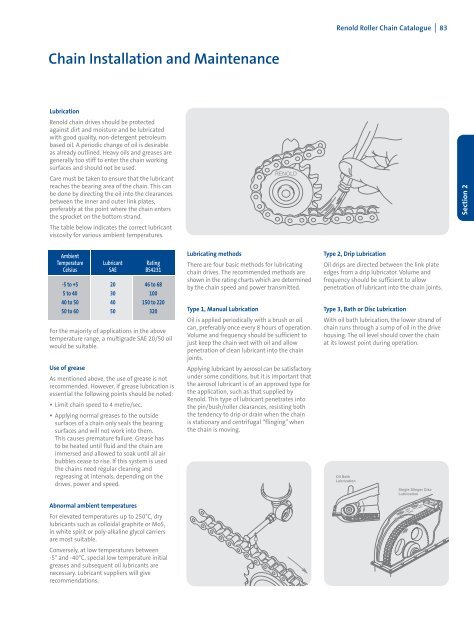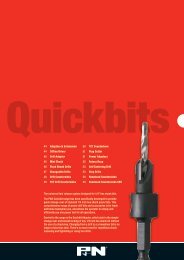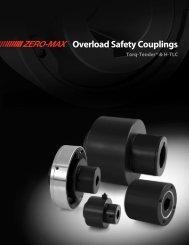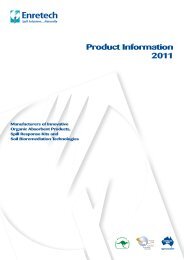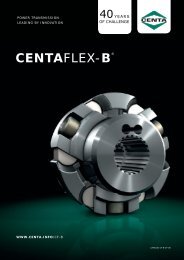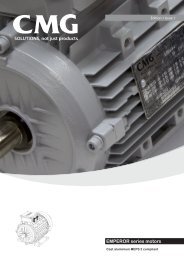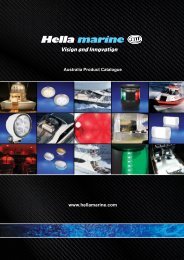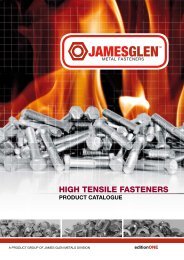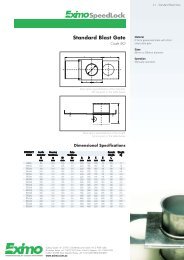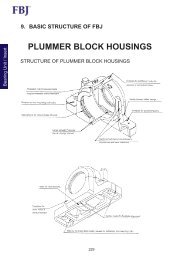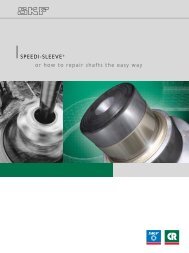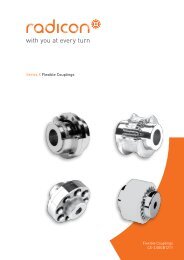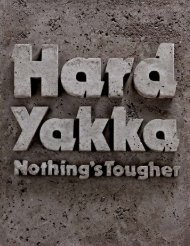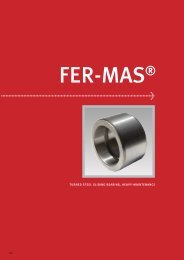Installation and Maintenance
Installation and Maintenance
Installation and Maintenance
You also want an ePaper? Increase the reach of your titles
YUMPU automatically turns print PDFs into web optimized ePapers that Google loves.
Renold Roller Chain Catalogue I 83<br />
Chain <strong>Installation</strong> <strong>and</strong> <strong>Maintenance</strong><br />
Lubrication<br />
Renold chain drives should be protected<br />
against dirt <strong>and</strong> moisture <strong>and</strong> be lubricated<br />
with good quality, non-detergent petroleum<br />
based oil. A periodic change of oil is desirable<br />
as already outlined. Heavy oils <strong>and</strong> greases are<br />
generally too stiff to enter the chain working<br />
surfaces <strong>and</strong> should not be used.<br />
Care must be taken to ensure that the lubricant<br />
reaches the bearing area of the chain. This can<br />
be done by directing the oil into the clearances<br />
between the inner <strong>and</strong> outer link plates,<br />
preferably at the point where the chain enters<br />
the sprocket on the bottom str<strong>and</strong>.<br />
The table below indicates the correct lubricant<br />
viscosity for various ambient temperatures.<br />
RENOLD<br />
Section 2<br />
Ambient<br />
Temperature Lubricant Rating<br />
Celsius SAE BS4231<br />
-5 to +5 20 46 to 68<br />
5 to 40 30 100<br />
40 to 50 40 150 to 220<br />
50 to 60 50 320<br />
For the majority of applications in the above<br />
temperature range, a multigrade SAE 20/50 oil<br />
would be suitable.<br />
Use of grease<br />
As mentioned above, the use of grease is not<br />
recommended. However, if grease lubrication is<br />
essential the following points should be noted:<br />
• Limit chain speed to 4 metre/sec.<br />
• Applying normal greases to the outside<br />
surfaces of a chain only seals the bearing<br />
surfaces <strong>and</strong> will not work into them.<br />
This causes premature failure. Grease has<br />
to be heated until fluid <strong>and</strong> the chain are<br />
immersed <strong>and</strong> allowed to soak until all air<br />
bubbles cease to rise. If this system is used<br />
the chains need regular cleaning <strong>and</strong><br />
regreasing at intervals, depending on the<br />
drives, power <strong>and</strong> speed.<br />
Lubricating methods<br />
There are four basic methods for lubricating<br />
chain drives. The recommended methods are<br />
shown in the rating charts which are determined<br />
by the chain speed <strong>and</strong> power transmitted.<br />
Type 1, Manual Lubrication<br />
Oil is applied periodically with a brush or oil<br />
can, preferably once every 8 hours of operation.<br />
Volume <strong>and</strong> frequency should be sufficient to<br />
just keep the chain wet with oil <strong>and</strong> allow<br />
penetration of clean lubricant into the chain<br />
joints.<br />
Applying lubricant by aerosol can be satisfactory<br />
under some conditions, but it is important that<br />
the aerosol lubricant is of an approved type for<br />
the application, such as that supplied by<br />
Renold. This type of lubricant penetrates into<br />
the pin/bush/roller clearances, resisting both<br />
the tendency to drip or drain when the chain<br />
is stationary <strong>and</strong> centrifugal “flinging” when<br />
the chain is moving.<br />
Type 2, Drip Lubrication<br />
Oil drips are directed between the link plate<br />
edges from a drip lubricator. Volume <strong>and</strong><br />
frequency should be sufficient to allow<br />
penetration of lubricant into the chain joints.<br />
Type 3, Bath or Disc Lubrication<br />
With oil bath lubrication, the lower str<strong>and</strong> of<br />
chain runs through a sump of oil in the drive<br />
housing. The oil level should cover the chain<br />
at its lowest point during operation.<br />
Abnormal ambient temperatures<br />
For elevated temperatures up to 250°C, dry<br />
lubricants such as colloidal graphite or MoS 2<br />
in white spirit or poly-alkaline glycol carriers<br />
are most suitable.<br />
Conversely, at low temperatures between<br />
-5° <strong>and</strong> -40°C, special low temperature initial<br />
greases <strong>and</strong> subsequent oil lubricants are<br />
necessary. Lubricant suppliers will give<br />
recommendations.


